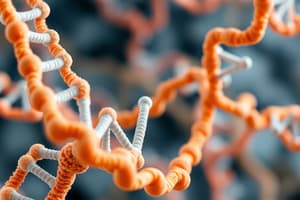Podcast
Questions and Answers
What role do sugars play in the formation of polysaccharides?
What role do sugars play in the formation of polysaccharides?
- They act as coenzymes.
- They serve as monomers. (correct)
- They perform lipid synthesis.
- They function as amino acids.
Which structure is not a recognized level of protein structure?
Which structure is not a recognized level of protein structure?
- Nucleic structure (correct)
- Primary structure
- Tertiary structure
- Quaternary structure
How many possible different protein sequences could a typical protein of about 400 amino acids long potentially have?
How many possible different protein sequences could a typical protein of about 400 amino acids long potentially have?
- 20,400 (correct)
- 40,800
- 64,000
- 2,048,000
What is the primary function of proteins within a cell?
What is the primary function of proteins within a cell?
During cell division, where is most of the DNA located in eukaryotic cells?
During cell division, where is most of the DNA located in eukaryotic cells?
What do nucleic acids primarily carry out in a cell?
What do nucleic acids primarily carry out in a cell?
What is the primary structural component of the prokaryotic cell wall?
What is the primary structural component of the prokaryotic cell wall?
Which type of DNA molecule is present in prokaryotic cells besides chromosomal DNA?
Which type of DNA molecule is present in prokaryotic cells besides chromosomal DNA?
Which statement best describes the role of polynucleotides in biological systems?
Which statement best describes the role of polynucleotides in biological systems?
What adaptation allows prokaryotic cells to thrive in extreme environments?
What adaptation allows prokaryotic cells to thrive in extreme environments?
What is the significance of nucleotide pairing in polynucleotides?
What is the significance of nucleotide pairing in polynucleotides?
Which of the following best characterizes the structure of present-day proteins?
Which of the following best characterizes the structure of present-day proteins?
Which structure of prokaryotic cells is responsible for movement?
Which structure of prokaryotic cells is responsible for movement?
Which component of the cell envelope is composed of lipopolysaccharides?
Which component of the cell envelope is composed of lipopolysaccharides?
How do specialized RNA molecules contribute to biochemical reactions?
How do specialized RNA molecules contribute to biochemical reactions?
What is the average diametric size range of bacterial cells?
What is the average diametric size range of bacterial cells?
What is the role of phospholipids in the formation of cell membranes?
What is the role of phospholipids in the formation of cell membranes?
What is the function of periplasm in prokaryotic cells?
What is the function of periplasm in prokaryotic cells?
What was likely a pivotal step in the evolution of early cellular life?
What was likely a pivotal step in the evolution of early cellular life?
What distinguishes RNA's role compared to DNA in present-day cells?
What distinguishes RNA's role compared to DNA in present-day cells?
How do prokaryotic cells compare to eukaryotic cells in size?
How do prokaryotic cells compare to eukaryotic cells in size?
Which of the following organisms is often classified as a prokaryote?
Which of the following organisms is often classified as a prokaryote?
How does the distinctive shape of RNA molecules impact their function?
How does the distinctive shape of RNA molecules impact their function?
Which characteristic is NOT typical of prokaryotic cells?
Which characteristic is NOT typical of prokaryotic cells?
Which of the following statements about cell membranes is accurate?
Which of the following statements about cell membranes is accurate?
What term describes cells with the capability to give rise to an entire organism?
What term describes cells with the capability to give rise to an entire organism?
Which of the following accurately describes the hierarchy of biological organization from simplest to most complex?
Which of the following accurately describes the hierarchy of biological organization from simplest to most complex?
Which statement about the zygote is true?
Which statement about the zygote is true?
What is the average diameter range of cells in a living organism?
What is the average diameter range of cells in a living organism?
Which level of organization includes everything in the levels below it?
Which level of organization includes everything in the levels below it?
Which of the following statements about reductionism is incorrect?
Which of the following statements about reductionism is incorrect?
What defines the internal mechanisms that determine the kind of organism developed from a zygote?
What defines the internal mechanisms that determine the kind of organism developed from a zygote?
What best describes the largest structure in biological terms?
What best describes the largest structure in biological terms?
Which of the following correctly distinguishes somatic cells from embryonic stem cells?
Which of the following correctly distinguishes somatic cells from embryonic stem cells?
Which molecule is primarily involved in the genetic instructions of a cell?
Which molecule is primarily involved in the genetic instructions of a cell?
Which organisms are classified as primary energy converters in ecosystems?
Which organisms are classified as primary energy converters in ecosystems?
What distinguishes inorganotrophic organisms from organotrophic organisms?
What distinguishes inorganotrophic organisms from organotrophic organisms?
Which of the following is an example of a chemoautotrophic organism?
Which of the following is an example of a chemoautotrophic organism?
How do decomposers contribute to nutrient cycling in an ecosystem?
How do decomposers contribute to nutrient cycling in an ecosystem?
Which of the following organisms can be classified as photoautotrophs?
Which of the following organisms can be classified as photoautotrophs?
Which statement accurately describes heterotrophs?
Which statement accurately describes heterotrophs?
What is the main source of free energy for living organisms in ecosystems?
What is the main source of free energy for living organisms in ecosystems?
Which is a characteristic of organotrophic organisms?
Which is a characteristic of organotrophic organisms?
Which type of organisms are primarily responsible for decomposing wood?
Which type of organisms are primarily responsible for decomposing wood?
What type of autotroph primarily utilizes sunlight for energy?
What type of autotroph primarily utilizes sunlight for energy?
Flashcards
Polynucleotides
Polynucleotides
Polynucleotides are random in length and sequence and can act as a template for synthesis, made of nucleotide pairs G-C and U-A.
RNA molecule shape
RNA molecule shape
RNA molecules adopt distinctive shapes due to nucleotide pairing.
DNA vs RNA roles
DNA vs RNA roles
DNA stores genetic information, while RNA directs protein synthesis.
Phospholipids in membranes
Phospholipids in membranes
Signup and view all the flashcards
Prokaryotic cells
Prokaryotic cells
Signup and view all the flashcards
Prokaryotic appendages
Prokaryotic appendages
Signup and view all the flashcards
Prokaryotic cell envelope
Prokaryotic cell envelope
Signup and view all the flashcards
Ecosystem energy
Ecosystem energy
Signup and view all the flashcards
Cellular Biopolymers
Cellular Biopolymers
Signup and view all the flashcards
Protein Diversity
Protein Diversity
Signup and view all the flashcards
Nucleic acid function
Nucleic acid function
Signup and view all the flashcards
Genome
Genome
Signup and view all the flashcards
Chromosome structure
Chromosome structure
Signup and view all the flashcards
Energy Input
Energy Input
Signup and view all the flashcards
Consumers (Heterotrophs)
Consumers (Heterotrophs)
Signup and view all the flashcards
Study Notes
Polynucleotides
- Polynucleotides are random in length and sequence.
- They can act as a template for the synthesis of another polynucleotide.
- They are made of nucleotide pairs: G with C and U with A
- Polynucleotides can direct their own synthesis.
Self-replicating Molecules
- RNA molecules can adopt a distinctive shape due to nucleotide pairing.
Evolution of Cells
- RNA molecules can catalyze biochemical reactions.
- DNA is the repository of genetic information, RNA acts as a go-between to direct protein synthesis.
First Cells
- Membranes were critical for forming the first cells.
- Phospholipids create the fundamental building blocks of all cell membranes.
- Membranes define the first cell.
Prokaryotic Cells
- Prokaryotic cells are significantly smaller than eukaryotic cells, meaning they can grow faster and multiply more rapidly.
- They come in many shapes and sizes.
- Bacteria are the most numerous prokaryotes.
- Cyanobacteria can be single-celled or filamentous chains of cells.
- Prokaryotic cells have been found 7 miles deep in the ocean and 40 miles up in the atmosphere.
Prokaryotic Cell Structure
- Appendages: Pili, Flagella, Axial Filaments
- Cell Envelope: Glycocalyx (Capsule), Outer Membrane, Cell Wall, Periplasm, Plasma or Cell Membrane
The Human Body
- Begins as a single cell (zygote).
- Has about 60-100 trillion cells.
- Contains about 200 different types of cells.
- Embryonic stem cells give rise to the entire body.
Comparative Sizes and Levels
- Cells can vary between 1 micrometer and hundreds of micrometers in diameter.
- Reductionism helps understand complex systems by studying their parts: atoms, molecules, chain molecules, molecular structures, cells, organs, organisms, populations, communities, ecosystems.
- Each level encompasses all lower levels.
Energy Flow in an Ecosystem
- Ecosystems require a constant supply of energy from sunlight or chemicals.
- Producers (Autotrophs) use sunlight or chemicals to make food.
- Photoautotrophs use sunlight: plants, algae, some bacteria.
- Chemoautotrophs use chemicals: microbes found in various inhospitable environments.
- Consumers (Heterotrophs) get energy by eating food.
- Herbivores: eat plants.
- Carnivores: eat animals.
- Omnivores: eat both plants and animals.
- Decomposers get energy by decomposing dead organisms.
- Fungi are the only organisms that decompose wood.
Monomers and Biopolymers
- Cells produce three types of large polymers: polysaccharides, proteins, and nucleic acids.
- Covalent and noncovalent interactions stabilize the molecules.
Proteins
- Proteins vary greatly in size, shape, and function.
- They enable different functions: small size hormones transmit signals, ion channels control ion concentration, and enzymes catalyze chemical reactions.
- Proteins commonly range in length from 100 to 1000 amino acids.
- If a protein is about 400 amino acids long, there are 20400 possible different protein sequences.
Nucleic Acids
- Nucleic acids carry coded information for making proteins.
Genome and Chromosomes
- The genome is packaged into chromosomes.
- Each chromosome contains a single linear DNA molecule associated with certain proteins.
- The genome of an organism comprises its entire complement of DNA.
Studying That Suits You
Use AI to generate personalized quizzes and flashcards to suit your learning preferences.




